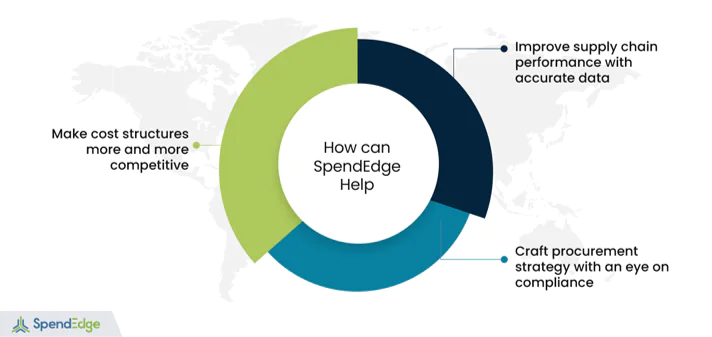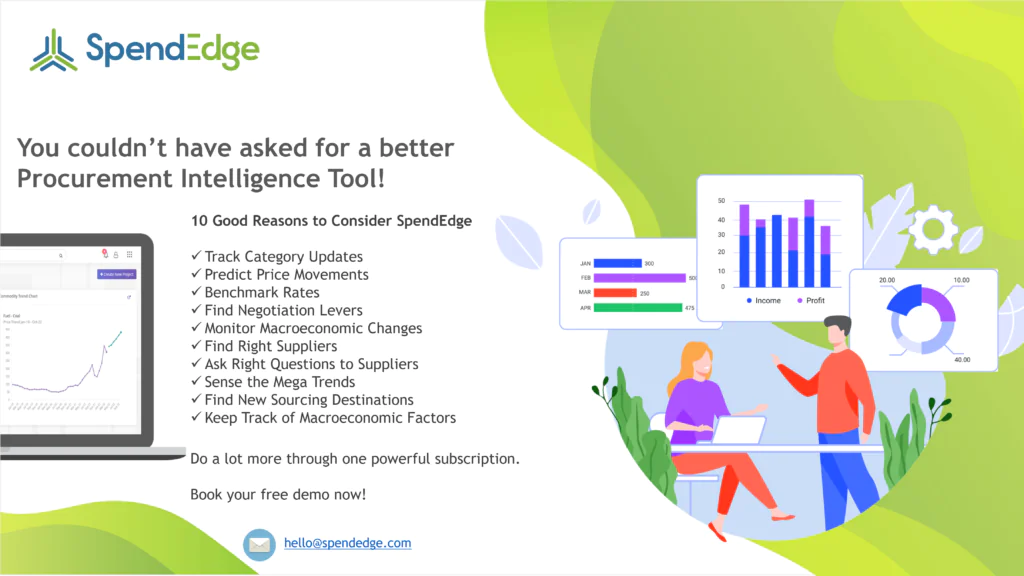By: Ankur Rishi
Key takeaways
- Telecom companies struggle with developing an effective procurement strategy due to high deployment costs, outdated infrastructure, and delays from OEMs. These challenges are compounded by inflationary pressures and price fluctuations.
- Telecom enterprises should prioritize modernizing legacy assets to reduce costs, enhance cybersecurity, and meet user demands while delivering value-added services efficiently.
- Widespread adoption of 5G technology is hindered by high costs, skill shortages, and deployment challenges, requiring a long-term telecom procurement strategy for successful implementation.
- Telecom companies face supply shocks with globalized supply chains, so proactive risk mitigation and procurement strategies are needed to reduce costs and improve network performance.
- At SpendEdge, we empower telecom companies to optimize procurement and enhance competitiveness by providing expertise in procurement strategy, cost-benefit analysis, and supplier negotiation with accurate data, compliance-focused strategies, and cost-efficient models.
The global telecom market, valued at a staggering $1,900 billion, is poised for exponential growth, nearly doubling by the decade’s end. A pivotal driver behind this surge is the telecom industry’s widespread adoption across diverse sectors such as e-commerce, retail, film, print, radio, television, IT, healthcare, as well as transportation and distribution. At the forefront of this revolution stands 5G, hailed as a game-changer not only for B2C but also for B2B realms, promising to carve out innovative revenue streams. With its allure of reduced latency, heightened capacity, and expanded bandwidth compared to its predecessor 4G, 5G fulfills long-standing user expectations.
More detailed view into the telecom procurement market
The realization of this transformative technology is hindered by various challenges, chief among them being the exorbitant deployment costs. Compounded by antiquated infrastructure with upkeep expenses disproportionate to their effectiveness, telcos find themselves shackled by outdated systems. Moreover, the telecom procurement landscape is marred by delays in sourcing essential network hardware from OEMs, further exacerbated by inflationary pressures and price fluctuations. In this complex milieu, crafting a solid telecom procurement strategy emerges as imperative for valuable and cost-efficient telecommunication providers.
Enter the realm of telecom contract management and telecom procurement, where strategic maneuvering becomes paramount. Whether through in-house procurement, leveraging the expertise of telecom procurement experts, or collaborating with telecom agents and aggregators, optimizing telecom expenditures necessitates a holistic approach. From telecom sourcing to meticulous telecom expense audits, every facet of the telecom procurement process demands scrutiny and refinement.
In essence, amidst the myriad challenges facing the telecom industry, a proactive stance coupled with a robust procurement strategy holds the key to navigating the complexities and unlocking unparalleled opportunities for growth and innovation.
With price swings, biting inflation, and sourcing delays consuming CPO bandwidths, just where is the time for telecom procurement strategy? Breathing new life into legacy assets should be the first concern of industry participants. Navigating the gridlocks in 5G deployment and easing squeezed supply networks ought to be important considerations for the sector.
Reasons why telecom markets must modernize legacy infrastructure
One of the significant hurdles to the digitization of the telecom system is the extensive use of legacy systems. By aggressively adopting modernization, leading telecom companies could reduce their service costs by 30% to 50%. Moreover, these assets are inefficient, low on speed and accuracy, and more vulnerable to cyber intrusions compared to present-day applications and state-of-the-art infrastructure. Bridging technical gaps to get legacy assets to “talk” with frontend applications can be so tiring. Therefore, it goes without saying that telecom enterprises must modernize their dated assets as a priority to pare costs, strengthen cybersecurity posture, and deliver value-added services to highly demanding users. These primary concerns ought to be the compass points of the telecom procurement strategy of the future.
5G rollout: Not a cakewalk
Speed-wise, 5G surpasses 4G by a factor of 10 at least. Even so, the share of this high-speed wireless internet in the North America market stands at a little more than 30%, as in April 2023. If 5G is too good and so cool, why is adoption lagging? Deployment doesn’t come cheap, once spectrum licensing, deployment fees due to regulators, and physical hardware are factored in. Particularly in the developing world, the telecom sector is shackled by the shortage of skilled resources capable of implementing 5G and allied technologies. For 5G rollouts to go as planned, businesses need a telecom procurement strategy that looks beyond short-term gains.
Challenges galore on the supply side
With such a globalized supply chain, it’s inevitable that the telecom sector will be exposed to supply shocks unless market participants take timely steps to curb such risks and improve overall supply-side performance. Cost increases on network hardware sourced from OEMs and supply delays are causing projects to go off course for both telecom operators. This has hit not just their revenue but network performance as well. Operators are increasingly reusing existing telecom equipment and pondering ways to extend the useful life of these assets, apart from expanding the supplier base. Many telecom players are also considering redesigning network topology to reduce over reliance on manufacturer equipment. Indeed, these forward-looking enterprises are riding the new wave in procurement strategy!
How SpendEdge can help you with your Telecom Procurement

Make cost structures more and more competitive
Increasingly, businesses are compelled to offer more efficient services, and in the process, end up compromising on the cost structure. This is a dangerous route to take since businesses risk slipping into the red in the not-too-long run! At SpendEdge, our experts, including in telecom procurement strategy and cost-benefit analysis, enable companies to keep their focus razor sharp on supply chain costs and develop superior negotiation strategies with suppliers. As a result, our clients are able to stay cost-competitive in relation to the competition.
Improve supply chain performance with accurate data
Monitoring supply chain data, processes, and tasks is key to staying abreast of inventory movement in real time. This is important when it comes to anticipating supply-side failures and developing workarounds before it’s too late. With regular feeds, updates, market intelligence reports, and best practices, SpendEdge puts deep and accurate information on sourcing at the fingertips of decision makers when they need it most! And when it comes to strategy for telecom procurement teams, we have all the scenarios covered.
Craft procurement strategy with an eye on compliance
At SpendEdge, our experts, including in telecom procurement strategy, work with businesses of all sizes across sectors to develop custom supplier strategies. This includes helping the client to zero-in on suppliers with demonstrated performance measures not limited to cost and fulfillment efficiency. We go the extra mile to ensure suppliers, including in the telecom sector, have an impeccable track record on the environment, social, and governance (ESG) front as well. Because we know that really resonates with a growing number of stakeholders who expect businesses to act responsibly!
Success story: A telecom beefs up negotiation leverage, fine-tunes its procurement strategy
Our client is a telecom industry player with annual revenue exceeding $2 billion, serving commercial and public sector customers. The client, a full-service wireless services business, delivers 4G LTE and 5G network services with wide coverage. Improving customer experience and enhancing network performance efficiency are high on the business’s agenda. To further this objective, the company has invested in advanced broadband infrastructure and next-gen wireless technologies and standards to ensure Internet reliability and high-speed access at rates that are easy on the wallet for the majority of users. The client is poised to grow faster than the industry average, though rising inflation might start to nibble at the margins, and this is a concern across the industry.
So, like most other telecom businesses, our client too needs to fine-tune the cost structure and its procurement strategy to cushion the inflationary impact. Essentially, the client had insufficient visibility into the cost breakdown of vendor-supplied offerings. The client’s procurement organization was keen on uncovering procurement pricing elements and developing in-depth understanding of how they impact the overall cost structure. As the next logical step, the client wanted to work out a low-cost product mix model to rein in overall costs and build leverage in the negotiations with incumbent suppliers.
The intent was to capture powerful bargaining advantages. By improving its grip on costs at a granular level, the client hoped to gain more headroom in negotiations, especially with influential suppliers. The end goal was to ensure a streamlined supply of network hardware and other third-party components at competitive rates. In the summer of 2022, the client took on board our experts in telecom procurement to assist its internal teams to perform a cost-benefit analysis of various supply-side participants.
At SpendEdge, our specialists in telecom procurement strategy follow a two-stage research methodology for cost benefit analysis, comprising primary and secondary data collection as well as qualitative and quantitative research measures. The study covered cost movement across all cost elements as defined by the client. Our approach helped the client get the full picture of how the cost pie stacks up for each product and vendor. Our team recommended utilization of cost-efficient models to craft a more impactful telecom procurement strategy and a clutch of negotiation tactics that would come in handy in the deliberations with the supply side. This is a procurement strategy that has stood many of our clients in good stead and earned them enough leverage in supplier negotiations.
Most of all, this no-nonsense approach to vendor cost management works by stripping away avoidable inefficiencies on the supply side that tend to pull up costs without adding an ounce of value. Based on our reporting of the supply-side cost structures, the client has initiated early steps to trim costs in the procurement function. Over and above that, the procurement organization is in the process of formulating an improved procurement strategy that is inlaid with proven negotiation methods.

Contact us now to solve your procurement problems!
Conclusion
The challenges confronting the telecommunications sector underscore the critical importance of a solid telecom procurement strategy. As the telecom industry braces for unprecedented growth, navigating the complexities of telecom contract management and telecom procurement becomes paramount. From optimizing telecom expenditures through strategic telecom sourcing to leveraging telecom procurement experts and exploring various forms of Telecom Procurement, proactive measures are essential. Whether through in-house procurement, collaboration with telecom agents and aggregators, or conducting thorough telecom expense audits, the path to success lies in a holistic approach.
By embracing modernization, enhancing supply chain performance, and crafting procurement strategies with an eye on compliance, valuable and cost-efficient telecommunication providers can unlock unparalleled opportunities for growth and innovation. Thus, in the dynamic landscape of the telecom industry, a relentless focus on lower telecom expenditures and effective procurement strategies is indispensable for staying ahead of the curve.
Author’s Details
Ankur Rishi
Vice President, Sourcing and Procurement Intelligence
With more than 12 years of advisory experience, Ankur manages platform content and services within the sourcing and procurement vertical. Over the years, Ankur has provided consulting services to category leaders from chemicals, energy, and packaging industry, on varied topics, such as category strategy, spend analysis, commodity pricing, and clean-sheet analysis.




